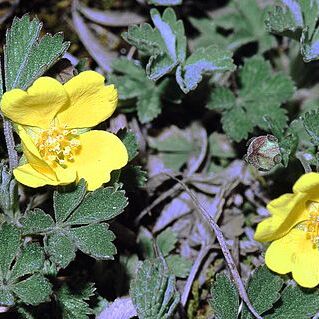Herbs of different habit, rarely shrubs. Leaves compound (palmate, pinnate, trifoliolate, rarely unifoliolate). Stipules adnate to the petiole, herbaceous or membranous. Flowers solitary and axillary or opposite the leaves, or in cymose or thyrsoid inflorescences, 5-(4-6)-merous, bisexual. Hypanthium (shallowly) cup-shaped, lined inside by a sometimes hairy disc. Epicalyx leaves often incised. Sepals valvate, usually entire. Petals entire, yellow or white, rarely red or purple. Stamens many (up to c. 30) to few. Pistils many to few, on low to elevated torus; ovaries superior, 1-locular; style apical, ventral or basal, persistent or jointed and deciduous; ovule 1, pendulous or ascending, inserted near the place of style-insertion. Fruits free, dry achenes or mesocarp slightly fleshy, surrounded by persistent epicalyx and calyx, torus rarely enlarging and becoming spongy to fleshy. Seed with thin testa.
Short-stemmed, perennial or rarely annual or biennial herbs or small shrubs, often mat-forming or sprawling and spreading, not armed. Lvs in basal rosettes or cauline or both, pinnate or palmate; leaflets usually dentate or crenate; stipules free in upper part, ± connate at base, persistent. Infl. a cyme or fls solitary, usually terminal. Fls small-to medium-sized, ☿, (4)-5-merous. Hypanthium ± flat or weakly concave, with a central, hemispheric dry or spongy receptacle (carpophore). Epicalyx segments lobed or entire. Calyx usually with triangular to lanceolate sepals. Petals ± obovate, usually white or yellow, rarely reddish, orange or purple. Stamens (10)-20-numerous. Ovary superior; carpels (4)-10-80; styles surrounded by hypanthium rim; ovules 1 per carpel. Fr. a head of 4-many achenes on surface of dry and spongy hypanthium; styles usually deciduous at fruiting.
Herbs perennial, rarely biennial, annual, or shrubs, if perennial then with ± tufted, scaly rootstock. Stems erect, ascending, or prostrate. Leaves pinnate or palmately compound; stipules ± adnate to petiole. Inflorescence often cymose or cymose-paniculate, or 1-flowered. Flowers usually bisexual. Hypanthium concave, mostly hemispheric. Sepals 5, valvate; epicalyx segments 5, alternating with sepals. Petals 5, often yellow, rarely white or purple. Stamens usually ca. 20 in 3 series of 10, 5, and 5, rarely fewer or more (11–30); anthers 2-loculed. Carpels usually numerous, free, inserted on slightly elevated receptacle; ovule ascending or pendulous, anatropous, amphitropous, or suborthotropous; style subterminal, lateral, or basal. Achenes numerous, inserted on dry receptacle with persistent sepals. Seed testa membranous. x = 7.
Cinquefoil or five-fingers, names applied to the spp. with 5 lfls. Hypanthium saucer-shaped to hemispheric; sep (4)5, alternating with as many, usually somewhat narrower or shorter, foliaceous bractlets; pet (4)5, diverse in size and shape; stamens 5–many, commonly 20; pistils inserted on a prolongation of the receptacle, (10–) numerous; ovaries short; ovule 1; style slender, terminal or lateral or nearly basal, articulated with the ovary; fr a head of achenes, often partly enclosed by the persistent, accrescent cal; herbs or small shrubs, with compound, stipulate lvs and small or medium-sized, yellow or seldom white or red-purple fls. x=7; many spp. are polyploid, or apomictic, or both. 200, N. Hemisphere.
Fls solitary to cymose; calyx 5-lobed, with 5 alt. bractlets; petals 5, us. yellow; stamens ∞, carpels us. ∞, receptacle dry, us. pubescent to pilose; achenes surrounded by persistent calyx, styles us. deciduous. Herbs or shrubs with compound lvs and adnate stipules. About 300 spp., mainly northern hemisphere. The N.Z. sp. is perhaps endemic, but is very closely related to the widespread P. anserina.

